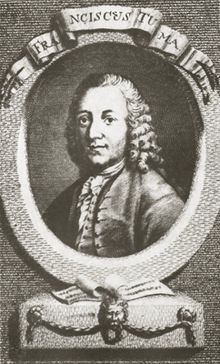Name Frantisek Tuma | Role Composer | |
 | ||
Died January 30, 1774, Vienna, Austria Similar People Bohuslav Matej Cernohorsky, Jan Zach, Jan Dismas Zelenka, Collegium 1704, Pavel Josef Vejvanovsky | ||
T ma trio sonata in a minor
Frantisek Ignac Antonin Tuma (Kostelec nad Orlici, Bohemia, October 2, 1704 – Vienna, January 30, 1774) was an important Czech composer of the Baroque era. Born in Kostelec nad Orlici, Bohemia, he lived the greater part of his life in Vienna, first as director of music for Count Franz Ferdinand Kinsky, later filling a similar office for the widow of Emperor Karl VI. He was an important late-baroque composer, organist, gambist and theorbist.
Contents
Life
Tuma received his early musical training from his father, parish organist at Kostelec, and probably studied at the Clementinum, an important Jesuit seminary in Prague. He likely sang as a tenor chorister under B.M. Cernohorsky (an important composer and organist) at the Minorite church of St. James, and he is believed to have received musical instruction from him. Tuma then went to Vienna, where he was active as a church musician; according to Marpurg he became a vice-Kapellmeister at Vienna in 1722. Tuma's name first appears in Viennese records in April 1729, when the birth of a son was recorded.
In 1731 he became Compositor und Capellen-Meister to Count Franz Ferdinand Kinsky, who was the High Chancellor of Bohemia. Kinsky's patronage made it possible for him to study counterpoint with J.J. Fux in Vienna. He participated in the premiere of Fux's opera Constanza e Fortezza along with Jiri Antonin Benda and Sylvius Leopold Weiss. In 1734, Kinsky recommended Tuma for the post of the Kapellmeister to Prague Cathedral, but his recommendation arrived too late and Tuma may have remained in Kinsky's service until the latter's death in 1741. In that year he was appointed Kapellmeister to the dowager empress, widow of Emperor Karl VI. On her death in 1750 Tuma received a pension.
For the next 18 years he remained in Vienna and was active as a composer and as a player on the bass viol and the theorbo; he was esteemed by the court and the nobility, and at least one work may have been commissioned from him by the Empress Maria Theresa. After the death of his wife in about 1768 Tuma lived at the Premonstratensian monastery of Geras (Lower Austria), but in his last illness he returned to Vienna and died in the convent of the Merciful Brethren at Leopoldstadt.
Style
Tuma's music belongs stylistically to the late Baroque. His sacred works, which were known to Haydn and Mozart, were noted by his contemporaries for their solidity of texture and their sensitive treatment of the text as well as for their chromaticism. His instrumental music includes trio and quartet sonatas, sinfonias and partitas, mostly for strings and continuo; some of them were clearly intended for orchestral use.
Among his sacred works we find some 65 masses, 29 psalms and 5 settings of the Stabat Mater.
